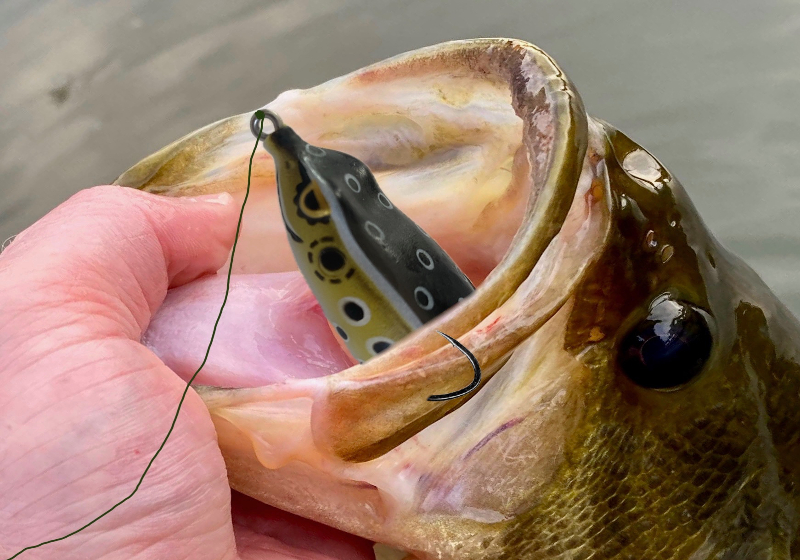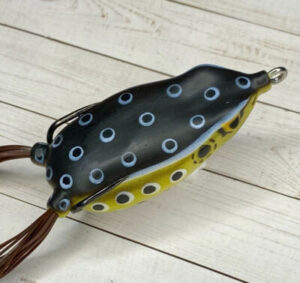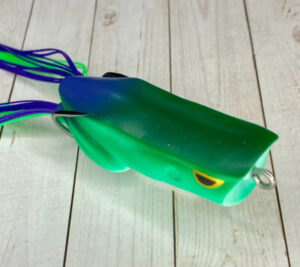
The science behind when to fish topwater lures is an intricate dance between science, anglers, and the environment, where success often hinges on timing and technique. Among tactics available to anglers, topwater fishing is an exhilarating and rewarding method. However, to truly master the art of topwater fishing, one must understand the optimal conditions and timings for employing this technique. This blog delves into the science behind when to fish topwater lures.
Understand Topwater Lures
Topwater lures mimic the movements of prey species like frogs, birds, or injured baitfish, enticing predatory fish to strike from below. These lures are designed to stay on the water’s surface, creating enticing ripples, splashes, and commotions that trigger aggressive reactions from gamefish. Depending on the topwater lure, anglers can fish rapidly, finesse, or a cast-and-retrieve technique. From walking baits, frogs, chuggers, and poppers, there are many lures designed for topwater fishing. The approach taken and the lures selected should be considered by many variables.
Dawn and Dusk – Prime Time for Topwater Action
Statistics gathered from numerous angling studies consistently point to dawn and dusk as prime feeding times for many freshwater and saltwater species. According to the Florida Fish and Wildlife Conservation Commission, predatory fish tend to be most active during low-light conditions, particularly during the first and last light of the day.
Ideal Topwater Lighting Conditions:
Low Light Conditions:
During these twilight periods, light levels are low, reducing the visibility of predators’ silhouettes to potential prey while providing cover for ambush. This low light coupled with the natural inclination of many prey species to become more active during these times creates ideal conditions for topwater strikes.
Overcast Days:
Cloud cover diffuses sunlight, creating a more subdued environment conducive to topwater fishing throughout the day.
Calm Waters:
Tranquil surface conditions allow for better presentation of topwater lures, as ripples or choppy water can disrupt the lure’s action and visibility.
Temperature & Seasonal Patterns for Topwater Lures
Water temperature plays a crucial role in fish behavior and can significantly influence the effectiveness of topwater lures. As a general rule, warmer water temperatures tend to increase fish activity levels and metabolism, making them more responsive to surface presentations.
During the warmer months of spring and summer, fish often move into shallower areas to feed, especially in the early morning and late evening when temperatures are more moderate.
Topwater Fishing Per Season
Spring:
As water temperatures rise, fish become more active, making spring an excellent season for topwater action. Look for areas with emerging vegetation, shallow flats, and spawning beds.
Summer:
Early mornings and late evenings are prime times during the summer months when fish seek refuge from the midday heat in shallow waters.
Fall:
As temperatures begin to cool, fish feed aggressively to prepare for winter. Target areas with submerged vegetation, rocky structures, and ambush points along shorelines.
Barometric Pressure for Topwater Fishing
Barometric pressure, a measure of atmospheric pressure, can significantly influence fish behavior and topwater fishing activity. While the relationship between barometric pressure and fishing success is complex and can vary depending on the species and environmental factors, many anglers have observed increased topwater action during periods of stable or falling barometric pressure.
According to Slamming Bass, decreasing barometric pressure causes fish to move into shallower water and become active. A decrease in barometric pressure results in the swim bladder of a fish expanding, making it easier for them to swim. During these periods, predatory species may become more aggressive and willing to strike at surface lures, making it an opportune time for topwater fishing.
Using Topwater Lures in Specific Locations
Understanding the specific habitat preferences of target species is crucial when selecting topwater fishing locations. While topwater lures can be effective in various environments, certain areas tend to produce better results than others.
Popular Areas to Fish Topwater Lures:
Structure and Cover:
Target areas with submerged vegetation, fallen trees, docks, and rocky outcrops. These structures provide shelter for baitfish and ambush points for predatory species. Topwater lures tend to work well in these areas because prey cannot see fish hiding below.
Shallow Waters:
Topwater lures excel in shallow areas where fish are more likely to feed near the surface. Focus on areas with depths ranging from a few inches to a few feet.
Transition Zones:
Look for areas where shallow flats meet deeper water, such as points, drop-offs, and channel edges. These transition zones often concentrate on feeding fish.
Conclusion – Science Behind Topwater Fishing
Topwater fishing is as much an art as a science, requiring anglers to understand the intricacies of fish behavior, environmental factors, and lure presentation techniques. By leveraging statistical data, expert insights, and an understanding of optimal conditions, anglers can maximize their success when fishing with topwater lures.
Whether it’s the thrill of an explosive surface strike at dawn, the anticipation of a subtle swirl at dusk, or the excitement of enticing a trophy fish from beneath the lily pads, topwater fishing offers an unparalleled angling experience. By timing your outings to coincide with low-light periods, favorable water temperatures, stable or falling barometric pressure, and selecting prime fishing locations, you can increase your chances of landing that trophy catch on the surface. So next time you hit the water, don’t forget to tie on a topwater lure and prepare for heart-pounding action that only surface fishing can provide.



Great article ! I love top water fishing, so a few of these facts, I already knew, but it’s always good to get more insight on this type of fishing.
🎣